Makefile Continue Command on Next Line
Introduction
The Linux make command is a commonly used utility by sysadmins and developers. The command assists in the compilation process and is a must-have tool for building large applications. This utility cuts out repetition and speeds up compilation, saving time.
This article will show you how to use the Linux make command with examples.

Prerequisites
- Access to the terminal.
- The
makefunction installed. - A text editor.
Note: If make is not available on the system, use sudo apt install make .
How Does the make Command Work?
The make command compiles different program pieces and builds a final executable. The purpose of make is to automate file compilation, making the process simpler and less time-consuming.
The command works with any programming language as long as the compiler can be executed with a shell command.
Compiling is straightforward when working with a few files. Therefore, the process includes invoking the compiler and listing file names.
For example, to compile a C program from three files (file1.c, file2.c, file3.h):

Invoke the compiler with:
gcc file1.c file2.c file3.h The gcc command creates an a.out file, which is a standard compiled executable.

However, changing one of the source files requires recompiling everything, which is even more complicated when working with large apps. The make command automates the process, allowing users to update only pieces that need to be changed without recompiling every file.
The make command uses a user-generated file, Makefile, to compile program pieces. When executed for the first time, make searches the Makefile for instructions, e.g., file descriptions and modification times. Based on the available data, make decides which files need to be updated and issues the necessary commands.
What Are Makefiles?
A Makefile is a text file containing a set of rules that instructs make how to build an application. A rule consists of three parts: the target, dependencies, and command(s).
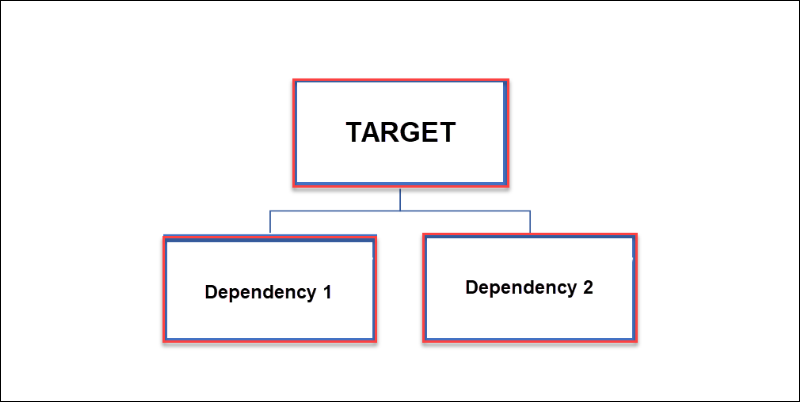
The Makefile basic syntax is:
target: dependencies <TAB> commands Parts of the syntax are:
- Targets. Names of the files to be created or updated after executing
make. - Dependencies. Names of the files (separated by spaces) from which the target is constructed.
- The commands. Rules describing how to create or update the target when dependencies change.
One Makefile has several sets of rules. The first rule is the default one and states how the final executable (the target) is to be made from not-yet-created object files (dependencies):
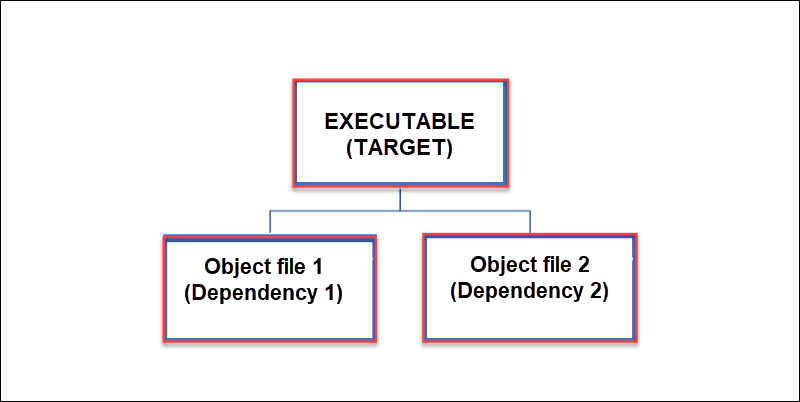
The syntax in this case is:
EXECUTABLE: Object file 1, Object file 2 <TAB> commands Note: The commands in Makefiles always come after the TAB key. Otherwise, the command does not work.
After setting rule one, the user adds instructions on how to create object files:
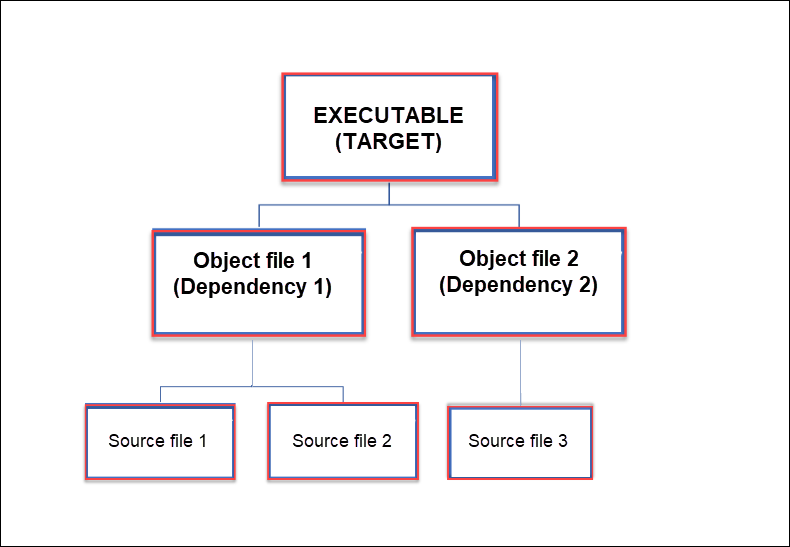
The make command works by compiling source files into object files and then compiling object files into the target file, the final executable. The Makefile syntax with the three rules mentioned above is:
EXECUTABLE: Object file 1, Object file 2 <TAB> commands Object file 1: Source file 1, Source file 2 <TAB> commands Object file 2: Source file 2 <TAB> commands Linux make Command Syntax
The basic make syntax looks like this:
make [OPTIONS] When executed without arguments, make builds the first target from the Makefile.
Linux make Command Options
The make command is widely used due to its effectiveness, variety, and the ability to perform specific actions. While the command prints result when run without options, adding arguments expands make's usability.
Here are the most used options:
| Command | Description |
|---|---|
-B , --always-make | Unconditionally compiles all targets. |
-d , --debug[=FLAGS] | Prints the debugging information. |
-C dir , --directory=dir | Changes the directory before executing the Makefile. |
-f file , --file=file , --Makefile=FILE | Uses a specific file as a Makefile. |
-i , --ignore-errors | Ignores all errors in commands. |
-I dir , --include-dir=dir | Specifies a directory to search for the specified Makefile. |
-j [jobs] , --jobs[=jobs] | Specifies the number of jobs to run simultaneously. |
-k , --keep-going | Continues running make for as long as possible after getting an error. |
-l [load] , --load-average[=load] | Specifies that no new task should be started if other tasks are in the queue. |
-n , --dry-run , --just-print , --recon | Prints expected output without executing make. |
-o file , --old-file=file , --assume-old=file | Ensures that make does not remake the file even if it is older than the dependencies. |
-p , --print-data-base | Prints the database produced after reading the Makefile. |
-q , --question | Activates the Question mode, in which make doesn't run any commands but returns an exit status zero if the target is already compiled. |
-r , --no-builtin-rules | Eliminates the built-in implicit rules. |
-s , --silent , --quiet | Restricts printing the commands as they are executed. |
-S , --no-keep-going , --stop | Stops " -k , --keep-going " command. |
-t , --touch | Touches files instead of running the commands. |
--trace | Traces each target's disposition. |
-W file , --what-if=file , --new-file=file , --assume-new=file | Ignores the fact that the target file has been modified. |
--warn-undefined-variables | Warns that an unknown variable is referenced. |
Linux make Command Examples
The best way to understand make and Makefiles is by running the command and different options on a simple program.
For example, to build an executable that prints the message "Learn about Makefiles", follow these steps:
1. Create a directory called Test.
2. Make three source files main.c, text.c, and text.h:

- main.c - is the file with the main function (
int main) that calls a function from another file.

- text.c - is the file with the you want to print "Learn about Makefiles!".

- text.h - is the header file with declarations for the functions. The header is included in both c files with the
#includeargument, which has the same purpose as copy/pasting the header's contents.

The following sections illustrate some common use cases of make and Makefiles on the three files mentioned above.
Note: The following examples are written in C language.
Create a Program
There are two ways to create a program:
- Compiling files the standard way by invoking the gcc compiler. This method is suitable for smaller programs.
- Using make and Makefiles.
Create a Program with gcc Compiler
Use the gcc compiler for simple programs only. Otherwise, use Makefiles when working with a large number of files.
To create a program with the compiler:
1. Open the terminal and navigate to the directory containing the files.
2. Invoke the gcc compiler and type the name of both c files. The header doesn't get compiled because it's already included in c files.
gcc main.c text.c 
3. List all the files in the current directory with the ls command:
ls 
The terminal shows that the new executable a.out file is created. The executable is also seen via a file explorer:
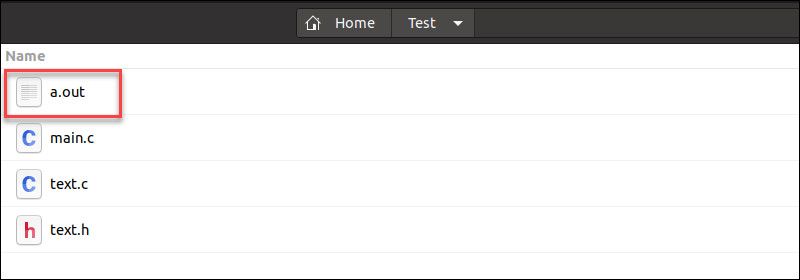
To test whether the compilation was successful, invoke the executable with:
./a.out 
The terminal shows that the executable works properly.
Create a Program with Make and Makefiles
Compiling files with make and Makefiles is simpler than using the compiler. Start by creating a new text document in the same directory and name it Makefile or makefile.
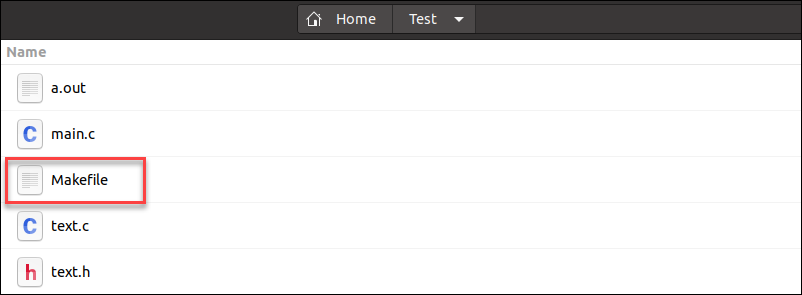
Open the file and use the basic Makefile syntax as the guideline:

1. Type the new executable's name as the target, for example, my_app.

2. Add object files main.o and text.o as the dependencies. The make command recompiles the target every time object files change.

3. Hit TAB and invoke the gcc compiler for the object files:
<TAB> gcc main.o text.o 
4. Add the -o flag and name the target my_app.

After writing the first rule, the Makefile looks like this:
my_app: main.o text.o <TAB> gcc main.o text.o -o my_app 
Next, instruct the Makefile on how to create main.o:
1. Set main.o as the target.
2. Type in main.c as the dependency. main.c serves to create and update main.o.
3. Write the following command to update main.o every time main.c changes:
gcc -c main.c 4. Add the -c flag to instruct the Makefile not to create a new executable but only to read the code and compile the object file.
main.o: main.c <TAB> gcc -c main.c 
To create text.o, set that file as the target, and add both text.c and text.h as dependencies. However, the gcc command only compiles the text.c file, since headers are never compiled:
text.o: text.c text.h <TAB> gcc -c text.c 
Save the Makefile and type make in the terminal.

The make command created two object files (main.o and text.o) and the executable (my_app).
To verify that make created new files, run ls again:

The terminal shows that running the command created my_app. To run the my_app file, type:
./my_app 
Update the Program
When one source file is changed, make only updates object files depending on that source file. For instance, to change the text displayed when running the my_app from "Learn about Makefiles" to "Where am I?":
1. Open text.c in the text editor:

2. Change the text to "Where am I?":

3. Save the file, open the terminal, and run make :

The make command detected changes in text.c and recompiled only that file.
To verify the change, run the executable:
./my_app 
Compile All Files
To compile all files and not only the changed files, use -B or --always-make options.
For example, to change the text in the text.c file back to "Learn about Makefiles" and save the file, enter:
make -B 
The output shows that make compiled all the files in the folder, even the ones that haven't been changed.
Clean Object Files
When a user runs make for the first time, the command creates object files and the executable. Therefore, to declutter the source folder and clean object files, add the clean function to the Makefile:
clean: <TAB> rm *.o my_app 
The command consists of:
- The clean target with no dependencies - the target is always considered outdated and always executed.
- The
rmcommand - removes specified objects. - The
*.opart - matches files with the o extension and cleans object files and my_app.
To clean object files, run:
make clean 
After running ls again, the terminal shows that the object files and my_app have been removed.
Run make in Debug Mode
Run make in debug mode to print additional info about the compiling process. Execute make with the -d option to display the debugging output:
make -d 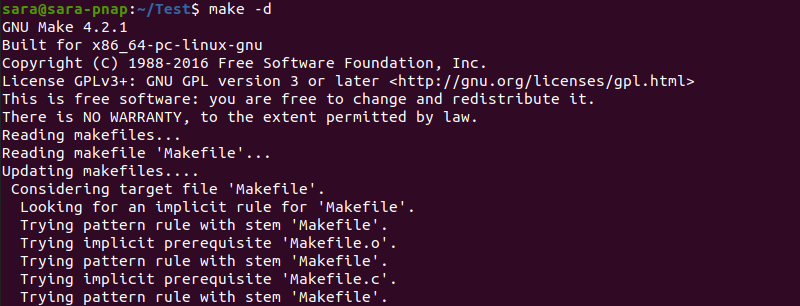
Use Different File as the Makefile
By default, make looks for a file called Makefile or makefile in the current directory. To use another file, run:
make -f [file_name] For example, if a Makefile is named my_file, execute:
make -f my_file 
Use Variables
Variables in Makefiles represent multiple file names, arguments, targets, dependencies, commands, source directories, or other items. Furthermore, a variable is defined by a name and represents a string of text called the variable's value.
To define a variable, use = . For example, substitute gcc with a variable C.
C=gcc my_app: main.o text.o <TAB> $ (C) main.o text.o -o my_app main.o:main.c <TAB> $ (C) -c main.c text.o: text.c text.h <TAB> $ (C) -c text.c 
When running make in the terminal, the command reads the C variable as gcc :

Conclusion
After going through the examples in this tutorial, you know how to use the make command in Linux and how it works.
Next, download the Linux commands cheat sheet to learn other important Linux commands.
Was this article helpful?
Yes No
Source: https://phoenixnap.com/kb/linux-make-command
0 Response to "Makefile Continue Command on Next Line"
Post a Comment